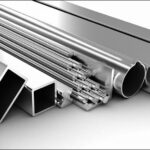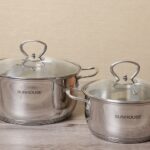Stainless Steel, commonly known as inox, is an alloy composed of metals such as Nickel, Chromium, Copper, Iron, Carbon, Manganese, Silicon, and more. This material stands out for its high durability, resistance to corrosion, and color retention, making it widely used in various everyday products.
The durability of inox depends on the mixture of metals like Chromium and Carbon. Inox exhibits excellent oxidation resistance when the steel contains a high percentage of Chromium. Currently, the most common types of inox are 201, 410, 304, 301, and 430.
Properties of Inox
Inox properties are categorized into 4 main groups, each with several subtypes:
- Austenitic: SUS 301, 304, 304L, 316, 316L, 321, 310s, etc.
- Ferritic: SUS 409, 410, 430, etc.
- Austenitic-Ferritic (Duplex): LDX 2101, SAF 2304, 2205, 253MA, etc.
- Martensitic: 420S45, 248SV, etc.
| Alloy Group | Magnetic | Corrosion Resistance | Ductility | Heat Resistance |
| Austenit | No | High | Very High | Very High |
| Duplex | Yes | Very High | Medium | Low |
| Ferritic | Yes | Medium | Medium | High |
| Martensitic | Yes | Medium | Low | Low |
| Precipitation Hardening | Yes | Medium | Medium | Low |

Common Types of Inox

Comparing Common Inox Types
Inox 304
Inox 201
Inox 316
Inox 430
How to Distinguish Common Inox Types
Using Acid

Using Specialized Test Kits

Using Toilet Bowl Cleaner

Using a Magnet

Frequently Asked Questions About Inox
What is Stainless Steel?
What is Inox and Its Applications in Manufacturing?
Why Doesn’t Inox Rust?
How is Inox Processed?
What are the Main Inox Products in Manufacturing?
How to Polish Inox for a Shiny Surface?
Can Inox Withstand High Temperatures?
How is Inox Used in the Food Industry?
Is Inox Highly Durable?
How to Clean and Maintain Inox Products?
What are the Common Inox Forms in Mechanical Engineering?
Why is Inox Ideal for Medical Products?
How to Weld Inox?
Is Inox Suitable for Marine Environments?
Why is Inox Called “Inox”?
Can Inox be Recycled?
What are the Common Inox Alloys?
Is Inox Used in Renewable Energy?
What are Inox’s Drawbacks?
Is Inox Used in Aerospace?
What Makes Inox Unique in Manufacturing?
Expert in web design and development with over 15 years of experience. I’ve helped hundreds of businesses develop comprehensive website strategies for sustainable growth and profitability.
The Ultimate Guide to Cleaning Stainless Steel Appliances
“Keeping stainless steel appliances and surfaces clean and shiny can be a challenge. Many have experienced the frustration of ending up with streaky or dirtier surfaces after cleaning. This is because not all cleaning agents are created equal, and some can even make stainless steel look worse than before. The secret to maintaining that pristine shine lies in using the right products and techniques.”
The Ultimate Guide: 3 Simple Steps to Remove Stubborn Sticker Residue from Your New Stainless Steel Pots and Pans
Introducing the ultimate guide to removing those pesky product information and price tags from your household items! Say goodbye to unsightly sticker residue on your pots, pans, and kitchen utensils. With our simple and effective methods, you’ll be able to effortlessly remove those stubborn adhesive marks and restore your belongings to their original glory. Join us as we explore the top 3 ways to eliminate sticker glue stains from your stainless steel cookware. Get ready to bid farewell to those annoying tags and hello to a clean and pristine kitchen!



































